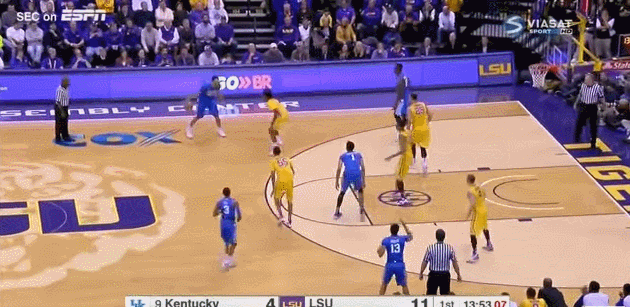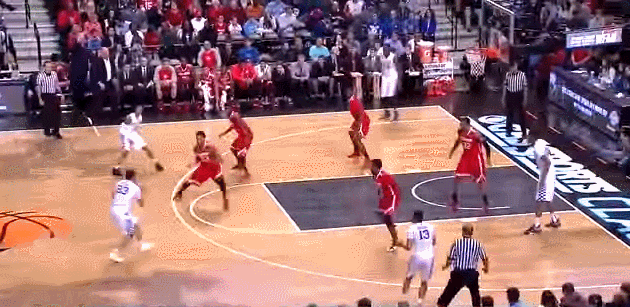Photo by Anthony Gruppuso-USA TODAY Sports
This article originally appeared on VICE Sports Canada.Two years ago, Andrew Wiggins became the second consecutive Canadian drafted No. 1 overall and led an historic class of four Canadian draft picks, three of them first-rounders. While Trey Lyles found himself in the lottery a season ago, it's the Kitchener, Ontario, product that followed him at Kentucky who was expected to continue the country's momentum atop the NBA Draft.Jamal Murray entered the season as a top-five prospect, having reclassified to the Class of 2016 on short notice to give head coach John Calipari's program a late and much-needed boost. Sixteen games into his freshman season, Murray's performed mostly well—averaging 17.6 points, 4.3 rebounds, and 2.6 assists with a 55.4 true-shooting percentage and 26.9-percent usage rate—as other elite Wildcats recruits have struggled. The heavy load speaks to Murray being the team's most important offensive player, even if he shares the reigns.Wherever he plays, his defence projects as average, at best. He's struggled to keep up with quicker players like Tim Quarterman and he doesn't have the strength or length for bigger wings like Ingram, especially when he has to fight through screens. Murray's not slow, necessarily, and puts in good effort, but he's not disruptive as a helper. He relies on the bigs behind him a fair amount, and the Wildcats have been better defensively when he sits.The lack of point guard production is an issue borne mostly out of a lack of opportunity, but concerns have manifested when he's played on the ball. Murray has struggled to create easy looks for teammates because he doesn't quite have the north-south burst to collapse defences. Instead, Murray creates degree-of-difficulty shots for himself in the absence of space. It's a testament to his immense skill level that he's already established himself as a bit of "a bad shot maker," to steal a phrase Kyle Lowry recently used to describe DeMar DeRozan.
Murray's not slow, necessarily, and puts in good effort, but he's not disruptive as a helper. He relies on the bigs behind him a fair amount, and the Wildcats have been better defensively when he sits.The lack of point guard production is an issue borne mostly out of a lack of opportunity, but concerns have manifested when he's played on the ball. Murray has struggled to create easy looks for teammates because he doesn't quite have the north-south burst to collapse defences. Instead, Murray creates degree-of-difficulty shots for himself in the absence of space. It's a testament to his immense skill level that he's already established himself as a bit of "a bad shot maker," to steal a phrase Kyle Lowry recently used to describe DeMar DeRozan. There's a bit of a chicken-or-egg question with this part of Murray's game. Kentucky is a woeful shooting team, often playing two bigs who can't really stretch the floor. Murray, easily the team's most reliable outside threat, has hit almost as many threes (42) as the rest of his team combined (48), and he's done so at a much better clip (his teammates are at 27.7 percent to his 38.5). So not only does Murray perhaps lack the elite athleticism to cause havoc getting into the teeth of a strong defence, but his team is constructed in a way that opponents can load up against it, anyway.
There's a bit of a chicken-or-egg question with this part of Murray's game. Kentucky is a woeful shooting team, often playing two bigs who can't really stretch the floor. Murray, easily the team's most reliable outside threat, has hit almost as many threes (42) as the rest of his team combined (48), and he's done so at a much better clip (his teammates are at 27.7 percent to his 38.5). So not only does Murray perhaps lack the elite athleticism to cause havoc getting into the teeth of a strong defence, but his team is constructed in a way that opponents can load up against it, anyway. This has resulted in Murray having to get very creative when he's not hitting triples, something he does with exceptional range. Murray's adept at changing speed and direction on his forays to the rim, keeping defenders guessing and making helping a tough proposition to navigate. He still needs work splitting the doubles that come often when he heats up—he's been Kentucky's go-to scorer in crunch time and when the offence stalls out, like when he scored ten consecutive points early in the first half against Alabama on Saturday—but he's developed a very effective floater that aids him in scoring against help at the rim.
This has resulted in Murray having to get very creative when he's not hitting triples, something he does with exceptional range. Murray's adept at changing speed and direction on his forays to the rim, keeping defenders guessing and making helping a tough proposition to navigate. He still needs work splitting the doubles that come often when he heats up—he's been Kentucky's go-to scorer in crunch time and when the offence stalls out, like when he scored ten consecutive points early in the first half against Alabama on Saturday—but he's developed a very effective floater that aids him in scoring against help at the rim. He's not elite at finishing over length, but has such good feel and timing that he's able to get his shot off before that becomes an issue. Murray's taking 23.6 percent of his shots at the rim, the good majority of them (64.7 percent) unassisted, and he's connecting on 64.2 percent of them. He's tough to guard in isolation despite ranking somewhere below elite on the athleticism scale, and he's been deadly attacking from a live dribble, which can happen when Ulis or Isaiah Briscoe are initiating.Sometimes, the lanes aren't there, and Murray's forced to pull-up off the bounce. He's only knocking down 31.7 percent of his jumpers inside the arc, and 90 percent of those shots are of the pull-up variety. The Wildcats can help Murray in that regard by getting him the ball more when he's on the move, as he's proven adept at hitting catch-and-shoot threes coming off screens or on curls. A strong 3-point clip and free-throw percentage (77.4 percent) suggest his shot isn't the issue, something the sound mechanics on his quick release back up, so it's easy to see his efficiency climbing as he improves his shot selection.
He's not elite at finishing over length, but has such good feel and timing that he's able to get his shot off before that becomes an issue. Murray's taking 23.6 percent of his shots at the rim, the good majority of them (64.7 percent) unassisted, and he's connecting on 64.2 percent of them. He's tough to guard in isolation despite ranking somewhere below elite on the athleticism scale, and he's been deadly attacking from a live dribble, which can happen when Ulis or Isaiah Briscoe are initiating.Sometimes, the lanes aren't there, and Murray's forced to pull-up off the bounce. He's only knocking down 31.7 percent of his jumpers inside the arc, and 90 percent of those shots are of the pull-up variety. The Wildcats can help Murray in that regard by getting him the ball more when he's on the move, as he's proven adept at hitting catch-and-shoot threes coming off screens or on curls. A strong 3-point clip and free-throw percentage (77.4 percent) suggest his shot isn't the issue, something the sound mechanics on his quick release back up, so it's easy to see his efficiency climbing as he improves his shot selection. The offence isn't a major concern, even if he's not a point guard. His worst-case scenario on that end is that of a shooting specialist, but he's so aggressive and creative when penetrating that even that seems like a long-shot downside.
The offence isn't a major concern, even if he's not a point guard. His worst-case scenario on that end is that of a shooting specialist, but he's so aggressive and creative when penetrating that even that seems like a long-shot downside. Scouts are justified in being unsure of what position Murray plays, but he has the right mix of size and skill to make either a long-term possibility. A team could potentially give him the Zach LaVine treatment and live with the learning process at the point, and if he doesn't figure it out, he'll have improved his playmaking for a move back to the two.What's clear is that Murray has NBA talent, regardless of position. He won't be able to pick up Wiggins' mantle atop the draft, not with the quality of the names ahead of him, but that shouldn't lessen the enthusiasm around Murray or Canada's pipeline of prospects. He remains a legitimate top ten prospect, a pivotal piece of the national program, and a must-watch draft stock heading into tournament season.Stats courtesy Hoop-Math and Ken-Pom.com.
Scouts are justified in being unsure of what position Murray plays, but he has the right mix of size and skill to make either a long-term possibility. A team could potentially give him the Zach LaVine treatment and live with the learning process at the point, and if he doesn't figure it out, he'll have improved his playmaking for a move back to the two.What's clear is that Murray has NBA talent, regardless of position. He won't be able to pick up Wiggins' mantle atop the draft, not with the quality of the names ahead of him, but that shouldn't lessen the enthusiasm around Murray or Canada's pipeline of prospects. He remains a legitimate top ten prospect, a pivotal piece of the national program, and a must-watch draft stock heading into tournament season.Stats courtesy Hoop-Math and Ken-Pom.com.
Advertisement
Concerns about his ultimate NBA upside, however, and the strong performances of other top names have him sliding down draft boards. ESPN's Chad Ford dropped him from fifth to eighth, while Murray fell two two spots to ninth in Draft Express' mock draft last week. Sam Vecenie of CBS Sports remains the most optimistic, handing Murray a No. 5 ranking, but even that serves to highlight that he's settled firmly in the draft's second tier, battling for position behind Ben Simmons, Brandon Ingram, Dragan Bender, and perhaps Henry EllensonPlaying mostly off the ball alongside fellow prospect Tyler Ulis, Murray hasn't been able to establish himself as a potential NBA point guard. If teams see Murray as a one, his size becomes a major plus. That advantage disappears, though, if he projects as a shooting guard. Murray is 6'5" with a 6'7" wingspan, but lacks the elite athleticism to make scouts as excited about his upside at the two.READ MORE: Kind Of Blue: Some Reasons Why Kentucky (Maybe) Might Not Be An Elite Team
Advertisement


Advertisement


Advertisement

